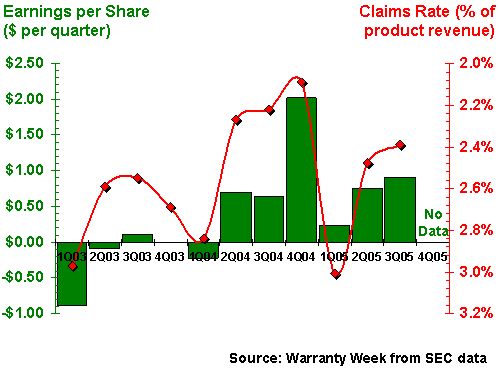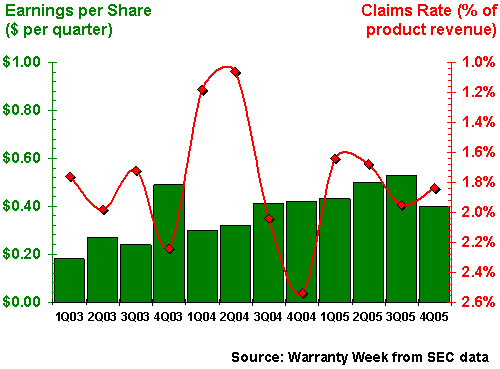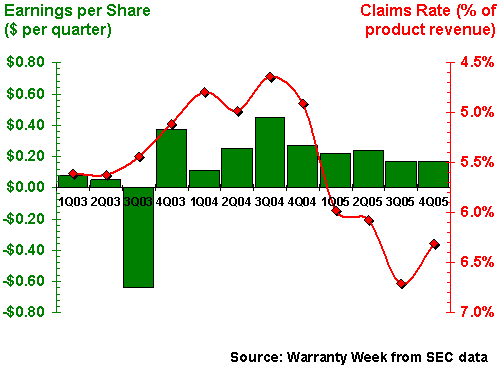Warranty vs. Earnings:
While a few Wall Street analysts are beginning to treat warranty as a leading economic indicator, fluctuations in claims rates don't always translate into earnings shifts. Yet warranty news is already moving stock prices.
Warranty expense reports evidently now have the power to move stock prices. Manufacturers that report increasing warranty costs may discover that stock analysts are now treating that data as a leading economic indicator -- a harbinger of increased costs and reduced earnings.
Recently, it's been happening with increasing frequency: someone with a calculator figures out that such-and-such a company's warranty claims rates are high, or predicts that they will soon go higher, thus reducing earnings. They put that nugget of news into a research report, and investors hungry for news dutifully bid share prices down.
The most recent such episode began on May 25 when the Ford Motor Co. announced it was delaying the launch of its redesigned F-Series Super Duty pickup truck until January 2007 in order to work out some quality issues. In a Reuters wire story filed that day, Deutsche Bank analyst Rod Lache said the diesel engine on the truck, which is manufactured by Navistar International Corp., has produced substantial warranty costs.
A Navistar spokesman retorted that he was not aware of any quality problems, and besides, Navistar was redesigning the pickup's engine to conform with new Environmental Protection Agency regulations. Separately, Navistar also raised its North American industry sales forecast for all heavy trucks, despite worries about the new EPA emissions standards. For its part, Ford responded by saying the decision to delay the new F-Series launch until the 2008 model year had actually been made late last year, although it wasn't actually announced until last month.
Warranty Costs to Soar?
On May 30, Peter Nesvold, the auto and auto parts/transportation equipment analyst at Bear Stearns & Co. Inc., downgraded Navistar from "peer perform" to "underperform." Part of his reason for doing so was related to his doubts about the prospects of German partner MAN AG taking an equity stake in Navistar. And part had to do with his predictions of a slowdown in sales next year, as Navistar faces the twin issues of the Ford delay and the new EPA regulations. Together, he said, these factors may produce "a material increase in warranty-related expense."
On the StarMine analyst ratings service, as relayed by the Yahoo! Finance Web site, Nesvold is the top-ranked analyst covering Navistar, with a five-out-of-five-star rating. No other analyst following the company received five stars, a rating which according to the company's methodology puts Nesvold in the top 10%. John McGinty of Credit Suisse received four stars; the other eight received three stars or less.
"To get a high score, an analyst must make estimates that are both significantly different from, and more accurate than, other analysts' estimates," the Web site states. Such a high ranking, it continues, "takes into account many factors, including the analyst's absolute earnings forecast error, that error compared to the forecast of other analysts, the variance of the errors, the timing of each revision, and the absolute value of the stock's actual reported earnings."
In other words, Nesvold is rated to be the most accurate forecaster of them all when it comes to Navistar. So it's no wonder that the company's share price fell by more than 5% that day, although much of that was giving back some of the previous week's gains produced by talk of MAN AG buying a stake in the company.
Business As Usual
On June 5, Navistar released a "letter to shareowners" from chairman Dan Ustian, in which the company threw cold water on predictions of reduced earnings. "As we said recently, we anticipate exceeding analyst expectations of $5.38 per diluted share for 2006. We also are positioning for a strong 2007 in spite of the anticipated softer demand for Class 8 trucks," Ustian said in his letter.
More specific to Nesvold's worries about the new engines, the company again said all is well. "With 2007 emissions regulations only months away, we have more than risen to the challenge, thanks to our industry-leading emissions technologies. We have already conducted extensive and satisfactory tests of our 2007 technology, which will go into production in the fourth quarter of 2006."
The letter also briefly mentioned Ford, although it did not address the postponed relaunch. The diesel engine that Navistar makes for Ford, Ustian told shareholders, "was honored when Truckin� magazine named the Ford Super Duty F-250 its "truck of the year." Our products continued to help drive Ford�s industry-leading market share in the U.S. heavy-duty pickup market."
He also did not address any warranty issues, real or imagined. Because of accounting investigations and possible restatements, Navistar has been late with the filing of its annual report for the fiscal year ended Oct. 31, 2005, as well as for the quarters ended Jan. 31 and April 30 of this year. So there's no recent facts or figures regarding either warranty expenses or earnings.
We'd love to report that there's this massive and just-discovered correlation between warranty expenses and earnings per share. But if there is one, it's slight. In the following chart, we're plotting Navistar's announced earnings per share (after their most recent restatement) against their calculated warranty claims rate (claims divided by product sales). The right-hand axis, representing claims rate, has for this outing reversed, in hopes that dips in claims rate will coincide with peaks in earnings per share.
Figure 1
Navistar International Corp.
Warranty Claims vs. Earnings per Share
In % of Sales and $ per Quarter
2003 to 2005

The peaks and valleys do seem to correlate to some degree, for instance in the fourth quarter of 2004 and in the first quarters of both 2003 and 2004. But notice also that Navistar's claims rate seems to peak on its own during the first quarter of each fiscal year, whether there are earnings or not.
Of course, both measures are highly dependent on sales volumes, so what we may actually be measuring could be nothing more than a seasonal fluctuation in the truck buying habits of Navistar's customers. The claims rate is calculated by dividing warranty claims into sales, so an increase in sales will on its own reduce the claims rate. And of course an increase in sales could increase net income if expenses don't also rise.
In addition, this whole fear-of-new-regulations theory is nothing new for the trucking industry. Way back in 2002, Cummins Inc. came up with new diesel engine technologies it called "cooled exhaust gas recirculation" and a "variable geometry turbocharger" to meet then-new EPA regulations on emissions. It must have scared off some potential buyers, because on March 19, 2003, the company announced an "Uptime Guarantee" policy under which Cummins would have reimbursed a customer for up to three days' truck rental if any part on their new EPA-compliant engine failed and couldn't be repaired within a 24-hour period.
That same year, Volvo Trucks North America took its new Class 8 trucks equipped with EPA-compliant engines on a "Drive the Future" road show, so that drivers and fleet owners could see for themselves that the new EPA-compliant technology wasn't so fearful. Sales had in fact plummeted after the new regulations took effect in October 2002 (see Warranty Week, April 28, 2003), but have since recovered.
Reduced Warranty Expenses
There's even less of a correlation between the warranty claims rate and earnings per share record of medical test and measurement vendor MTS Systems Corp. In January, the company announced a rise in gross profitability to 44.2% in its first fiscal quarter of 2006 (corresponding to the fourth calendar quarter of 2005), up from 42.7% a year before. This, it said, was "favorably impacted by reduced warranty expense and favorable capacity utilization."
Yes, the company's claims rate had fallen significantly, from 2.5% in 2004 to 1.8% in 2005 (the scale below is reversed), but did earnings per share move? Even the company's own press release admits that earnings per share were down 2% from one year to the next. So although gross profitability was favorably impacted, other factors evidently kept earnings from rising.
Figure 2
MTS Systems Corp.
Warranty Claims vs. Earnings per Share
In % of Sales and $ per Quarter
2003 to 2005

What's apparent in Figure 2 is that earnings and warranty claims are pursuing completely independent paths at MTS. It's clear that claims were highest at the end of 2004 and were lowest at the beginning of that year. And in 2005, claims and earnings have moved in completely opposite directions.
Finally, also in January, the stock of Novellus Systems Inc. was impacted when a research report noted the chip-making equipment company's relatively high warranty claims rates. In a Jan. 10 article about local companies (which is no longer online), the San Jose Mercury News reported that the per-share price of Novellus common stock lost 77 cents, or 3 percent, after Morgan Stanley analysts Timm Schulze-Melander and Shashin Shah cut their ratings to "underweight/attractive" from "equal-weight/in-line" -- whatever that means -- because they thought that extra warranty costs were weighing on the company's profits.
Take a look at the chart below. For Novellus, 11 of the past 12 quarters have been profitable. And yes, the highest quarterly earnings per share (in the third quarter of 2004) corresponded to the lowest claims rate. But in the quarters since, the claims rate has slowly inched up from 4.6% to 6.7%, before falling back slightly to 6.3%. And earnings? They've remained in a range of 17 to 27 cents per share.
Figure 3
Novellus Systems Inc.
Warranty Claims vs. Earnings per Share
In % of Sales and $ per Quarter
2003 to 2005

So in reality, by the time Morgan Stanley published its research report on Jan. 10, the company's claims rate was actually declining. And that decline has continued into 2006, with the latest data showing a 5.8% claims rate for Novellus in the first quarter. And earnings were actually down slightly from the year before, when the claims rate first hit 6%. So if anything, Morgan Stanley's report was a year late.
The bottom line, if you'll pardon the pun, is that while warranty costs can be used as a leading indicator of a company's manufacturing quality, and while sudden spikes in warranty costs can foreshadow sudden declines in earnings, it's not always so straightforward. First of all, the whole purpose of a warranty reserve fund is to partially shield a company's net income from fluctuations in warranty costs. Second, there's always something of a lag time between when a product is made (when the initial warranty accrual is set aside), and when the impact of its repair costs arises. And third, even though warranty can consume 1% to 5% of a typical company's product revenue, there are numerous other factors that can easily overshadow the impact of warranty cost fluctuations.








